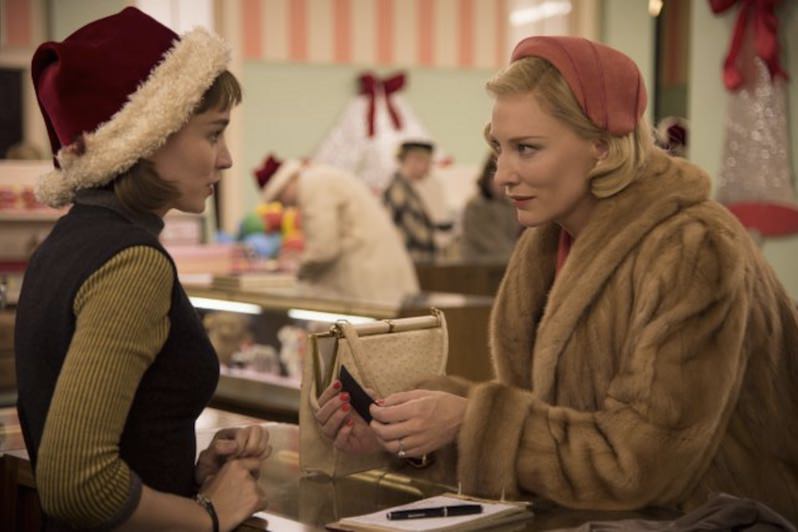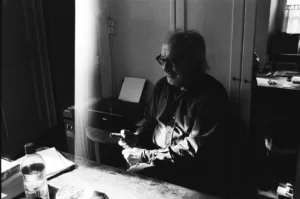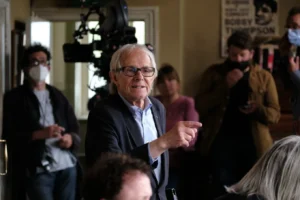‘Carol’ Film Review: The Art Nearly Upstages the Artistry
Cate Blanchett and Rooney Mara are beautifully balanced in this love story, but Todd Haynes’ overstylized cinematography is downright distracting. IMDb
IMDb
Todd Haynes’ movie “Carol” stars Cate Blanchett as its golden heroine, an elegant married lady metaphorically lost in New Jersey horse country circa 1950.
More captivating, though, is Therese, played by Rooney Mara, an elfin young woman working at a Manhattan department store while trying to find herself.
The wife and the waif meet during Christmas rush as Carol looks for a gift for her daughter. Therese suggests a train set. Carol agrees, and leaves her delivery address and—accidentally on purpose—her gloves with the shopgirl.
Based on the 1952 Patricia Highsmith novel “The Price of Salt,” the movie chronicles the women as they lose and find themselves as lovers, much to the disgust of Carol’s husband, Harge (Kyle Chandler), who is a stock villain. He will do anything to salvage his marriage to her, including threatening, should she leave him, to deny her visitation with their beloved daughter.
With a filmography that includes “Far From Heaven” and “Velvet Goldmine,” Haynes has long been fascinated with how, in prior eras, the love that dare not speak its name introduced itself. Here it is a matter of an appraising glance met by another. And of Therese gently caressing Carol’s gloves with a tenderness probably not seen in films since Marlon Brando’s Terry Malloy rescued the gloves of Eva Marie Saint’s Edie Doyle in “On the Waterfront.”
Haynes is a colorist who assigns emotional meaning to each shade in the spectrum of his film. Once again collaborating with cinematographer Ed Lachman, Haynes lights his film so that it glows with the coral and celadon tints one might find in 1950s Kodachrome snapshots. While “Carol” looks like it could be an artifact from the Eisenhower decade, its color-coded palette is distracting. That I noticed that the shades of Carol’s blond pageboy coif exactly match those of her mink coat suggests to me that the color detracts from, rather than amplifies, the story.
Another artifact of the 1950s: Blanchett’s distractingly mannered performance in the film’s first third. Given the masklike face and Kabuki stylings, it’s like Bette Davis doing a Joan Crawford impression. The slash of vermilion lipstick on Blanchett’s mouth looks slightly out of registration, as though she were a character in a comic strip or a Roy Lichtenstein painting. It’s another distancing device intruding between viewer and story.
Happily, when Carol and Therese are together, the film no longer is art-directed to the point of suffocation and starts being about the relationship. Only then does it get to the pith and marrow of things and become about two people in love. The fifth wheel is the wonderful Sarah Paulson as Carol’s ex, as clear-sighted and supportive as Carol is dreamy and scattered.
Can world-weary Carol be a mother and the lover of another woman without sacrificing either part of who she is? Can timid Therese be coaxed out of her cocoon and find love—and a meaningful career?
The two lead performances, the overplayer and the underplayer, complement each other wonderfully. Blanchett is broad and breathy, and Mara, resembling the fawnlike Audrey Hepburn, contained and terse. A lot of the acting is of the speak-to-me-only-with-thine-eyes sort, which casts a spell considerably more intoxicating than that of period cars, costumes and decors.
Mara, who received the supporting actress prize at Cannes for her part as Therese, is mostly monosyllabic and saucer-eyed. After being indifferent to the men chasing her, Therese is palpably transformed by her relationship with Carol. Mara plays it as one who has gone from “Is That All There Is?” to “How Long Has This Been Going On?” She is enchanting.
Your support matters…Independent journalism is under threat and overshadowed by heavily funded mainstream media.
You can help level the playing field. Become a member.
Your tax-deductible contribution keeps us digging beneath the headlines to give you thought-provoking, investigative reporting and analysis that unearths what's really happening- without compromise.
Give today to support our courageous, independent journalists.






You need to be a supporter to comment.
There are currently no responses to this article.
Be the first to respond.